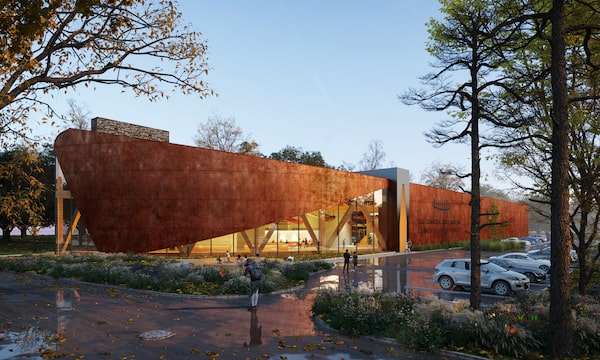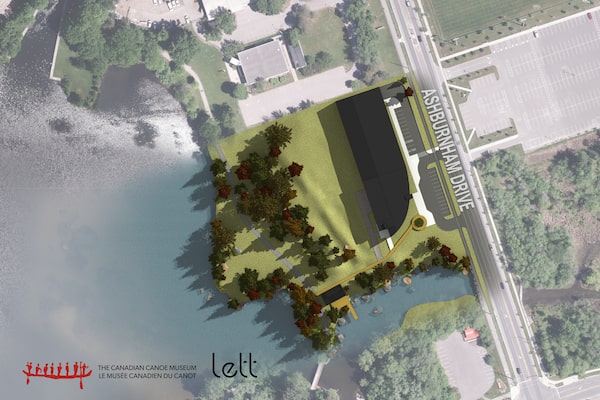Jeremy Ward, left, curator for The Canadian Canoe Museum, stands alongside Carolyn Hyslop, the museum's executive director, inside a storage facility housing hundreds of canoes ready to be moved in Peterborough on Monday, Dec. 5, 2022. Alex Filipe/The Globe and MailAlex Filipe/The Globe and Mail
It seemed like it might never lift.
All morning and into the afternoon, a late November fog lay over Peterborough like a cheap COVID mask, smothering sightlines for walkers and drivers in this small city in central Ontario.
Then, almost as if someone had just switched on the lights, the fog lifted, the sun alone brighter than the yellow Douglas fir beams rising from a fresh construction site soon to form the entrance for the brand-new, and much-delayed, Canadian Canoe Museum.
“I can’t put it in words,” said an excited Carolyn Hyslop, long-time executive director of the museum that, eight years ago, the Senate of Canada declared “a cultural asset of national significance.”
“It’s so perfect,” Ms. Hyslop added. “It’s … impossible.”

The new museum under construction on Dec. 5, and an architect's drawing of what the finished facility will look like.Alex Filipe/The Globe and Mail; Lett Architects Inc., courtesy of Canadian Canoe Museum
It was very much almost impossible. The original canoe museum was established in 1997 in a land-locked, former outboard-motor factory. Few ever missed the ironies.
A new museum was planned for its 25th anniversary, which would have been last summer. Unfortunately, the project ran into choppy waters that ranged from pandemic delays to one unexpected bump the size of a Class VI rapid.
Instead of dumping and putting a quick end to the voyage, however, this unexpected wave launched the project into new space and better flow, sort of a modern Flying Canoe fable that is headed for a happy ending.
Some three years back, Ms. Hyslop and her management team thought they had found a “perfect” new location. It would be next to the famous Peterborough Lift Lock along central Ontario’s Trent-Severn Waterway. The city’s two best tourist attractions would be side by side.
It was certainly time to move. The collection had grown to some 650 canoes and kayaks, with more than 500 of them stored in a dismal back building not accessible to the public. The old Outboard Marine Corporation facility had closed in 1990. Seven years later, the canoe collection – originally started by Kirk Wipper at a popular summer canoe-tripping camp – would take over the abandoned buildings by paying the now-bankrupt company a single dollar.
Students visit the canoe museum's old site in 2019, a former factory for Outboard Marine Corporation.Fred Thornhill/The Globe and Mail
The planned new museum by the lock had the blessing of Parks Canada and the City of Peterborough. Fundraising had gone so well that most of the expected costs had been raised. The new facility would feature a natural green roof and a wildflower meadow.
There was great excitement – right up until the spring of 2020, when inspectors found traces of the industrial solvent trichloroethylene and other chemicals throughout the property. Groundwater had seeped from slightly higher land that once held a watch factory.
The only way to make it work would be to first clean up both sites, which proved far too expensive when costed out.
There was also concern that a venue celebrating the cleanest and most natural form of transportation would be standing on lands that industry had once degraded. Not a good look.
“We had to pivot,” says curator Jeremy Ward, who has been with the museum since 1998.
“We had to start from scratch.”

The museum's new site on Little Lake was more affordable than what was previously planned.Lett Architects Inc., courtesy of Canadian Canoe Museum
Then they got lucky. The city offered to sell them a five-acre site on Little Lake, a charming widening of the Otonabee River as it passes near the downtown.
The price was an affordable $1.57-million and they easily decided to go ahead with the new option.
Surrounded by parkland and close to the Trans Canada Trail, the new museum will now have water access, docks, canoe launches and an accessible launch area for kayakers.
It would feature its own “portage” from the popular walking and biking trail to the Douglas fir timber entrance.
“We are really excited about the canoe museum,” Eleanor McMahon said when the Little Lake location was announced.
As president and CEO of the Trans Canada Trail, which began in 1992 and now stretches some 28,000 kilometres from ocean to ocean. Ms. McMahon appreciates that multiple sections of the trail can be accessed by canoe.
Drafting plans for the new facility site in an office trailer at the new museum site.Alex Filipe/The Globe and Mail
The museum planners stuck with their original designers, Lett Architects of Peterborough, and all 160 volunteers offered to stay on until completion. Virtually all major supporters remain on board: the federal government committing $10-million; the province, $9-million; the Garfield Weston Foundation, $7.5-million.
Further funding has come from the city, and private donors have contributed more than $19-million. The final cost will be in the neighbourhood of $40-million, of which 95 per cent has been raised. There is a current effort under way to raise $500,000 from the public as part of a campaign called “Move the collection.” Several hundred canoes are bubble-wrapped, stacked and waiting in the old museum warehouse to be relocated to the new facility.
A most intriguing contribution comes from Toronto-Dominion Bank, which has committed $500,000 over five years so that people from eight Indigenous communities can be hired. The museum is situated on Treaty 20 Michi Saagiig territory and the traditional territory covered by the Williams Treaties First Nations. The Michi Saagiig dialect of Anishinaabemowin will be used throughout the museum alongside English and French.
Fittingly, last summer, Mary Simon, the first Indigenous Governor-General, agreed to stand as the museum’s patron. She is the first GG to commit to such a role with the museum.
“The change of venue has been transformational,” Ms. Hyslop says.
:format(jpeg)/cloudfront-us-east-1.images.arcpublishing.com/tgam/43CFWGYZDVCZHGTFMOH2F36NZ4.JPG)
:format(jpeg)/cloudfront-us-east-1.images.arcpublishing.com/tgam/2Q7462KILJD5DKYW4GIPTBQEXE.jpg)
:format(jpeg)/cloudfront-us-east-1.images.arcpublishing.com/tgam/OCNPRU3C4JBYDCZEGMFGMAXQCY.jpg)
The museum on Little Lake will be 65,000 square feet and able to show all the canoes and kayaks in the vast collection in a single exhibition hall. It will have a studio where canoes will be built and there will be a library and research rooms.
A large upper terrace can be opened in good weather. The museum expects to accommodate weddings, conferences and other events, with a banquet table capable of seating 150 for dinner. Glass panels inside will feature a massive map of Canadian waterways designed by local cartographer Chris Brackley.
But there will also be an outdoor campus. “Our hope,” says Mr. Ward, the curator, “is that our new building will inspire people to go outside.”
The museum is planning for 87,000 visitors a year, three times the number before the pandemic.
When construction began on the property, many large ash trees had to come down, as they were dead or dying from the emerald ash borer. That wood will be milled and used in workshops on canoe construction and paddle making.
Not only are there hiking trails and parkland, but Little Lake has beaches and shoreline where, on this particular sunny day, hundreds of ducks and geese were gathering and a sole, dignified great blue heron was hunting.
The museum will feature boardwalks taking visitors to various areas where there could be bannock baking, storytelling or a campfire circle. There will be a large tent for outdoor events. There will also be a Canoe House, which Ms. Hyslop sees as “a community hub.” They expect to hold summer camps for area youth.
Ms. Hyslop brushes the plastic wrap on a canoe built by Todd Labrador.Alex Filipe/The Globe and Mail
The museum has commissioned the building of brand-new vessels, as well. A kayak will be built in Iqaluit and brought to Peterborough. Nova Scotia’s Mi’kmaw canoe builder Todd Labrador – “One who dances on water” – will construct a traditional canoe out of birchbark.
“They’ll be brand new,” Ms. Hyslop says of the commissioned vessels. “They don’t have their stories yet. They won’t have ever been used. We plan to invite the builders and their families to come here and take their creations for a paddle.
“We need them to come alive again, feel the water.”
On a day like this, with the fog lifted, you can indeed feel the draw of the water as dozens of hikers and bikers are on the trails.
Beyond the windows and across Little Lake is an ancient cemetery filled with large, impressive trees, meaning there should never be a condo project to block what the people of Peterborough have long held to be the best sunsets to be found.
First showing of those sunsets from the museum terrace is now expected to be early July, 2023 – a year late, but the best delay ever.